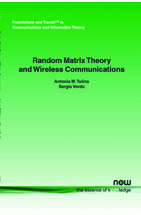Random Matrix Theory and Wireless Communications
By Antonia M. Tulino, Dept. Ingegneria Elettronica e delle Telecomunicazion, i Universita degli Studi di Napoli "Federico II", Italy | Sergio Verdú, Dept. Electrical Engineering, Princeton University, USA
Abstract
Random matrix theory has found many applications in physics, statistics and engineering since its inception. Although early developments were motivated by practical experimental problems, random matrices are now used in fields as diverse as Riemann hypothesis, stochastic differential equations, condensed matter physics, statistical physics, chaotic systems, numerical linear algebra, neural networks, multivariate statistics, information theory, signal processing and small-world networks. This article provides a tutorial on random matrices which provides an overview of the theory and brings together in one source the most significant results recently obtained. Furthermore, the application of random matrix theory to the fundamental limits of wireless communication channels is described in depth.
Random Matrix Theory and Wireless Communications
Random matrix theory has found many applications in physics, statistics and engineering since its inception. Although early developments were motivated by practical experimental problems, random matrices are now used in fields as diverse as Riemann hypothesis, stochastic differential equations, condensed matter physics, statistical physics, chaotic systems, numerical linear algebra, neural networks, multivariate statistics, information theory, signal processing and small-world networks.
Random Matrix Theory and Wireless Communications is the first tutorial on random matrices which provides an overview of the theory and brings together in one source the most significant results recently obtained. Furthermore, the application of random matrix theory to the fundamental limits of wireless communication channels is described in depth. The authors have created a uniquely comprehensive work that provides the reader with a full understanding of the foundations of random matrix theory and demonstrates the trends of their applications, particularly in wireless communications.
Random Matrix Theory and Wireless Communications is a valuable resource for all students and researchers working on the cutting edge of wireless communications.
